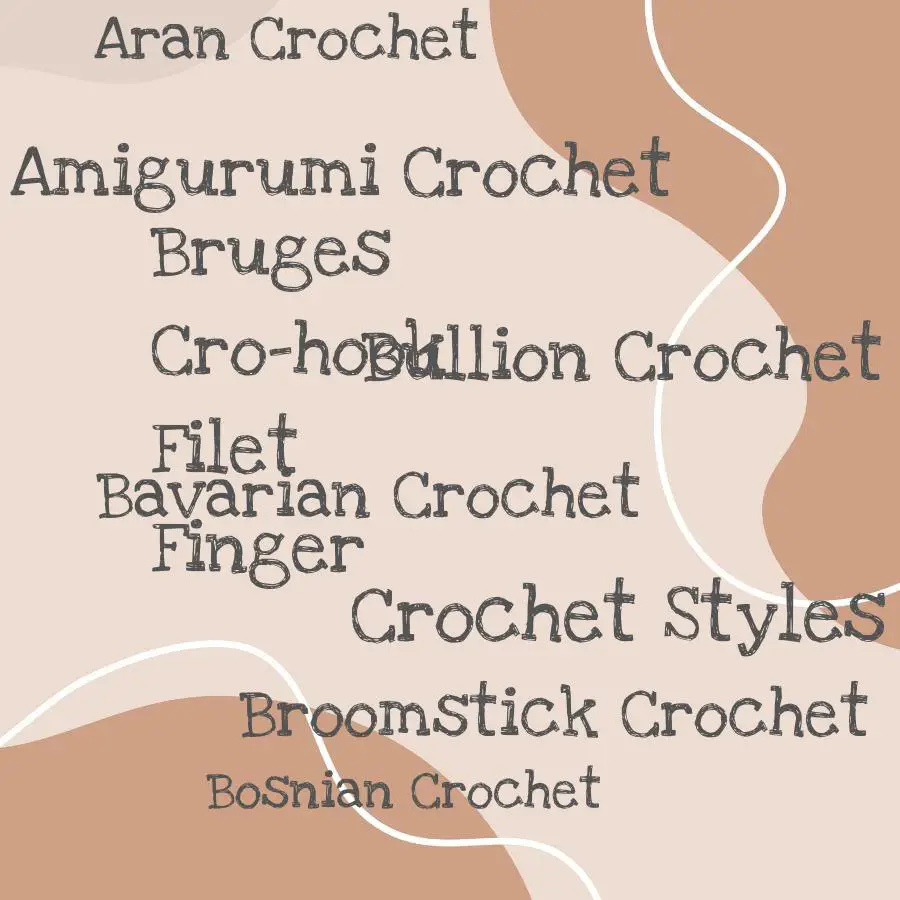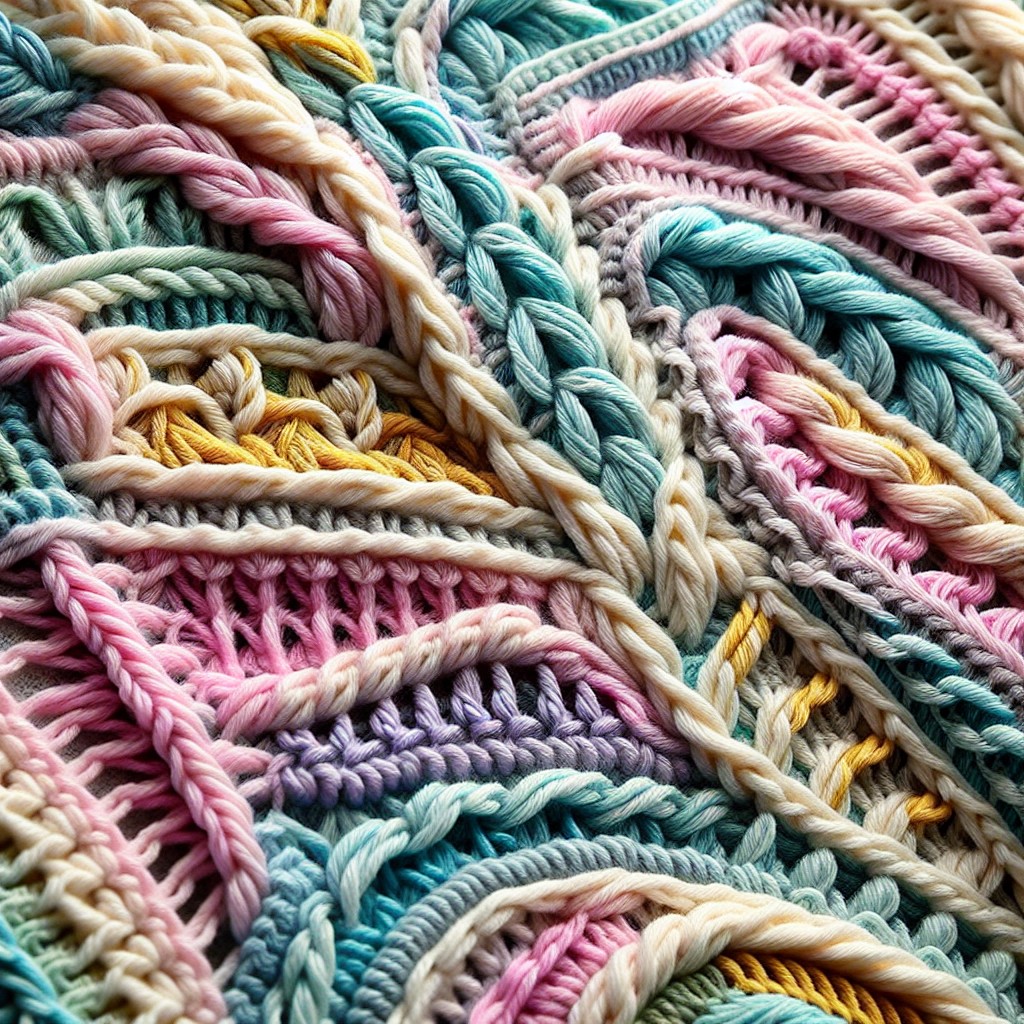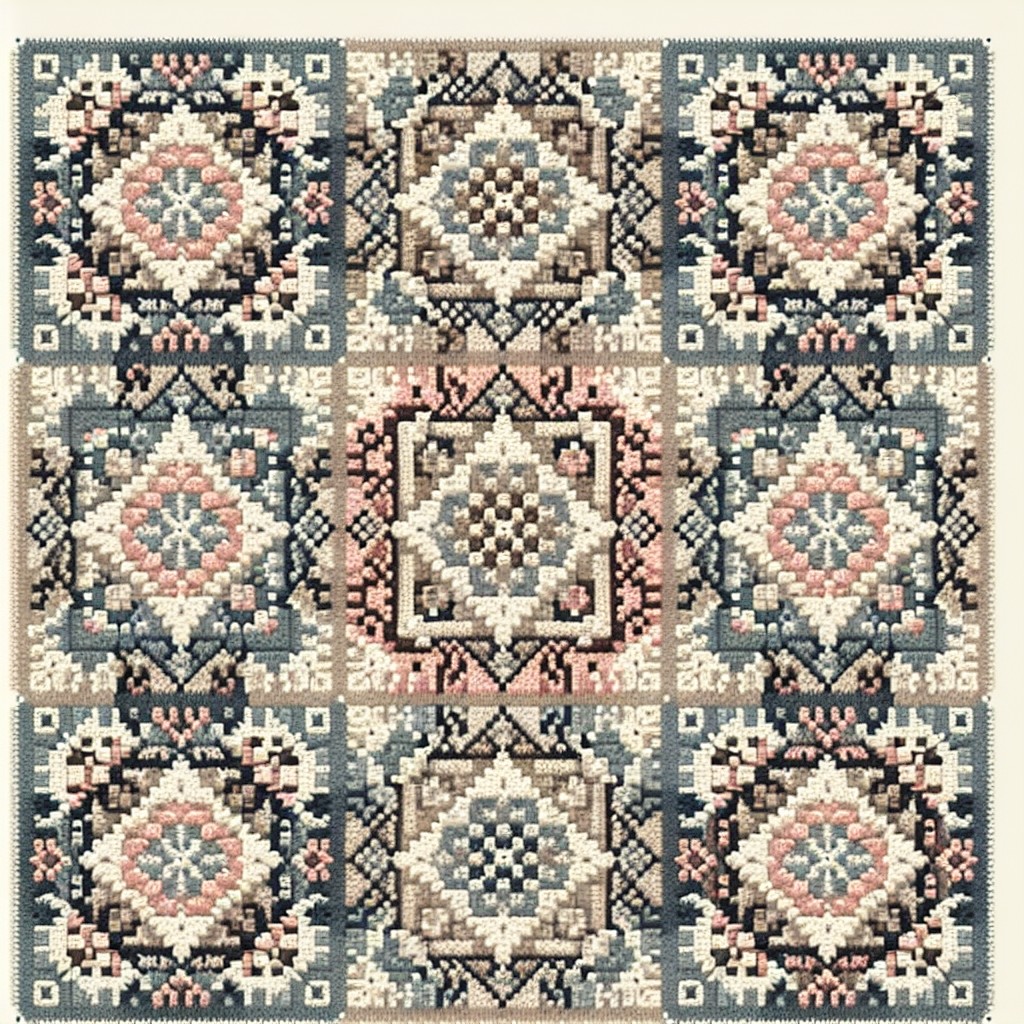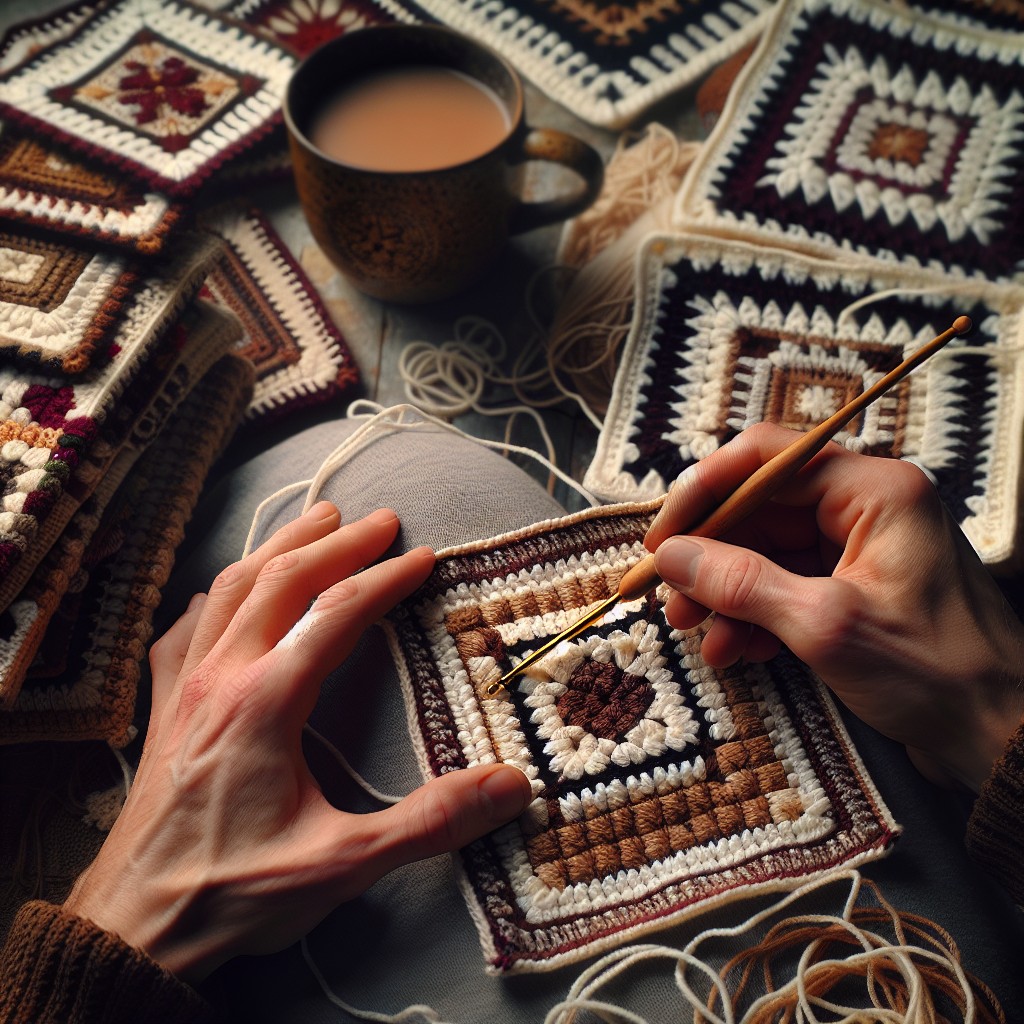Discover the wonderful world of crochet, as we delve into various styles and techniques that will unleash your creativity and elevate your crafting skills.
Crochet is a wonderful craft that has been around for centuries. It involves using a hook to create intricate designs and patterns with yarn or thread.
One of the best things about crochet is that there are so many different styles and techniques to choose from! Whether you’re a beginner or an experienced crocheter, it’s always fun to learn new ways of creating beautiful pieces. In this blog post, we’ll explore some of the most popular types of crochet styles out there.
From Tunisian crochet to filet crochet, we’ll cover everything you need to know about these unique techniques. So grab your hook and let’s get started!
Amigurumi Crochet

Amigurumi Crochet is a Japanese style of crochet that involves creating small, stuffed animals and other cute creatures. These adorable little toys are perfect for children or anyone who loves cute things! Amigurumi patterns typically use single crochet stitches worked in the round to create a seamless, three-dimensional shape.
The key to making successful amigurumi is using the right type of yarn and hook size so that your finished project has a tight stitch pattern that holds its shape well.
One great thing about amigurumi is how customizable it can be – you can make any animal or character you like by simply changing up the colors and details. There are also many free patterns available online if you’re looking for inspiration or guidance on how to get started with this fun technique.
Aran Crochet

This technique involves using cable stitches, bobbles, and other textured patterns to create intricate designs on blankets, scarves, hats or any other crochet project you can think of.
One of the most popular patterns used in Aran Crochet is the cable stitch. This stitch creates a braided effect that adds depth and texture to your work.
Another common pattern used in this style is the diamond stitch which creates an elegant diamond shape design.
Bavarian Crochet

This technique involves creating intricate designs using only double crochets and chain stitches. The result is a beautiful, textured fabric that looks almost like it was knitted.
One of the best things about Bavarian crochet is its versatility. You can use this technique to create everything from blankets and scarves to hats and bags.
Plus, once you get the hang of it, Bavarian crochet can be quite addictive! It’s easy to see why so many people have fallen in love with this style.
To get started with Bavarian crochet, all you need are some basic supplies: yarn (preferably worsted weight), a hook (size H or I works well), and scissors. Then follow these simple steps:
- ) Make a slip knot on your hook.
- ) Chain 5 stitches.
- ) Slip stitch into first chain stitch to form ring.
- ) Chain 3 stitches (counts as first double crochet).
- ) Work two more double crochets into ring for total of three dc’s
- ) Chain 2; work three more dc’s into ring for total of six dc’s separated by ch-2 spaces
- ) Repeat step #6 twice more until there are four sets each consisting six dcs separated by ch-2 spaces
Bosnian Crochet

This technique involves working with two colors of yarn at the same time and interlocking them to create intricate patterns. Unlike traditional crochet where you work in rows or rounds, Bosnian crochet is worked in a continuous spiral.
One of the benefits of Bosnian crochet is that it produces reversible fabric with no right or wrong side. This makes it perfect for creating items like scarves, blankets, and bags where both sides will be visible.
To get started with Bosnian Crochet, you’ll need to learn how to make the basic slip stitch which forms the foundation for this technique. Once you’ve mastered this stitch pattern using one color yarn then move on to learning how two-colors are used together while crocheting.
Bullion Crochet
These stitches are made by wrapping the yarn around the hook several times before pulling it through the loop on your hook. The result is a beautiful, textured stitch that can be used to create stunning designs.
One of the most challenging aspects of Bullion Crochet is getting those twists just right. It takes practice and patience to master this technique, but once you do, you’ll be able to create some truly amazing pieces.
Bullion Crochet can be used in many different ways – from adding texture to blankets and scarves to creating delicate lace patterns for shawls or doilies. This style of crochet requires a bit more time and effort than some other techniques but produces results that are well worth it.
If you’re interested in trying out Bullion Crochet for yourself, there are plenty of resources available online with step-by-step instructions on how to get started.
Broomstick Crochet
This technique creates an open, lacy fabric that’s perfect for shawls, scarves, and other lightweight accessories.
To get started with Broomstick Crochet, you’ll need a few basic supplies: yarn (preferably something lightweight), a large knitting needle or dowel (traditionally made from broomsticks hence the name), and your trusty crochet hook.
The first step is to create your foundation chain using the crochet hook. Once you have your chain ready, insert the knitting needle into each stitch along the row.
Then wrap yarn around both needles together and pull up loops through each stitch on the hook until all stitches are transferred onto it.
Next comes working off those stitches by pulling them over one another in groups of five at once while keeping them on top of broomstick/dowel before returning them back onto crocheting hook again for next set until end-of-row where last loop will be worked as usual single-crochet-stitch.
Bruges Crochet
This technique involves creating lace-like designs using thin thread or yarn, which are then joined together to form larger pieces such as shawls, doilies, and table runners.
The name “Bruges” comes from the city of Bruges in Belgium where this style was first developed. It’s characterized by its intricate patterns created with chains and double crochet stitches worked into loops on either side of a central chain.
One unique aspect of Bruges crochet is that it often incorporates ribbon or other materials into the design for added texture and dimensionality. This makes it an excellent choice for creating delicate accessories like necklaces or bracelets.
If you’re interested in trying out this beautiful technique, there are plenty of resources available online to help you get started.
Clothesline Crochet
This style of crochet creates sturdy and durable pieces, making it perfect for creating baskets, rugs, and other home decor items.
To get started with clothesline crochet, you’ll need to choose a suitable cord or rope. Cotton clotheslines are popular choices because they’re easy to work with and come in various colors.
Once you have your materials ready, start by crocheting around the cord using single or double crochets.
One great thing about this technique is that it allows for endless creativity! You can experiment with different stitches like popcorns or shells to create unique textures on your projects. You can also add embellishments like beads or tassels to make them even more special.
Clones Lace Crochet
It’s known for its intricate designs and delicate lacework, which makes it perfect for creating beautiful doilies, table runners, and other decorative items. This technique involves using fine thread or yarn to create small motifs that are then joined together to form larger pieces.
To create Clones Lace Crochet, you’ll need a small hook (usually around 1mm) and very fine thread or yarn. The stitches used in this technique are typically quite simple – mostly double crochets and chains – but the real beauty comes from the way these stitches are combined to create complex patterns.
One of the most interesting things about Clones Lace Crochet is how it evolved over time. Originally created by nuns as a way to earn money for their convents, this style of crochet was passed down through generations until it became an important part of Irish heritage.
Today, many people still practice Clones Lace Crochet as both a hobby and an art form. While it can be challenging due to its intricate nature, there’s nothing quite like seeing your finished piece come together after hours (or even days!) of work.
Cro-hook Crochet
It involves using a special hook with two ends to create beautiful designs and patterns. The hook has a crochet hook on one end and a knitting needle on the other.
With this technique, you can create pieces that have the look of knitted fabric but are actually made with crochet stitches. Cro-hooking allows for more intricate designs than traditional knitting or crocheting alone.
To get started with cro-hooking, you’ll need to purchase a specialized double-ended hook in your desired size. You’ll also need yarn in your preferred color(s) and weight.
Once you’ve got all your materials ready, it’s time to start practicing! There are many tutorials available online that can help guide you through the process of learning how to use this unique tool effectively.
Filet Crochet
This style involves creating a mesh-like fabric with open spaces and filled-in blocks to create beautiful patterns. Filet crochet is often used to make doilies, tablecloths, curtains or even clothing items like shawls.
To get started with filet crochet, all you need is some yarn and a hook. The basic stitches used in this technique are chain stitches (ch), double crochets (dc) and spaces between them which form the mesh pattern.
One of the best things about filet crochet is its versatility – it can be worked in any color combination or thickness of yarn depending on your preference. You can also experiment with different stitch combinations to create unique designs that reflect your personal style.
Finger Crochet
As the name suggests, this technique involves using your fingers instead of a hook to create stitches. It’s perfect for beginners who are still getting used to holding a hook or those who want to work on larger projects without having to constantly switch hooks.
To get started with finger crochet, all you need is some yarn and your hands! Simply make a slip knot as usual and place it over one of your fingers. Then use your other hand (or even both hands) to pull the yarn through the loop on your finger.
Repeat this process until you have created enough stitches for whatever project you’re working on.
One great thing about finger crocheting is that it can be done anywhere at any time – no tools required! You can easily take some yarn with you wherever you go and work on small projects during breaks or while waiting in line.
Freeform Crochet
This technique involves creating pieces without following any specific pattern or design. Instead, it’s all about using your imagination and experimenting with different stitches and colors to create unique works of art.
One of the best things about freeform crochet is that there are no rules! You can use any type of yarn or thread, as well as any size hook. And because there’s no set pattern to follow, you have complete freedom when it comes to shaping your piece.
To get started with freeform crochet, simply choose a few colors that inspire you and start crocheting in whatever stitch feels right at the moment. As you go along, add in new colors and textures for an even more eclectic look.
Hairpin Crochet
This technique was popular in the early 1900s and has recently made a comeback in the world of crochet. Hairpin crochet can be used to make anything from delicate doilies to cozy blankets.
To get started with hairpin crochet, you’ll need a hairpin lace loom and some yarn. The loom consists of two parallel metal rods connected by small bars at each end.
You’ll use your hook to work loops around these bars, creating long strips of fabric that can be joined together or left as-is for an openwork effect.
One great thing about hairpin crochet is its versatility – you can use any weight or type of yarn with this technique! Thicker yarns will produce chunky pieces while finer threads will result in delicate lacework.
If you’re new to hairpin crochet, there are plenty of tutorials available online that can help guide you through the process step-by-step.
Micro Crochet
This technique involves using very fine thread and a tiny hook to create intricate designs that are smaller than your fingernail! It requires patience and precision, but the results can be truly stunning. Micro crochet is often used to make delicate jewelry pieces such as earrings or necklaces, as well as miniature animals or other objects.
To get started with micro crochet, it’s important to choose the right materials. You’ll need very fine thread (usually size 80 or higher) and an appropriately sized hook (usually between 0.4mm-1mm).
The stitches are incredibly small so it’s important to have good lighting and work in a quiet environment where you can concentrate fully on your project.
One of the biggest challenges of micro crochet is keeping track of your stitches since they’re so small! It’s helpful to use stitch markers or count each stitch carefully after completing each row.
Overlay Crochet
This style of crochet is perfect for creating intricate designs and patterns, as well as adding depth to your projects.
To get started with overlay crochet, you’ll need to have some basic knowledge of traditional crochet stitches. Once you’ve mastered the basics, you can begin experimenting with different colors and textures to create unique designs.
One popular way to use overlay crochet is by creating mandalas or doilies. These circular pieces are perfect for showcasing the layered effect created by this technique.
You can also use overlay crochet in larger projects like blankets or shawls, where it adds an extra dimension of texture.
Pineapple Crochet
The name comes from the pineapple-like shapes that are created by clusters of stitches worked together in groups of three or more. This technique can be used to create stunning doilies, table runners, shawls, and even clothing.
To get started with Pineapple Crochet, you’ll need to have some experience with basic crochet stitches like chains and double crochets. Once you’ve mastered those skills, it’s time to move on to creating the pineapple motifs themselves.
The key to successful Pineapple Crochet is paying close attention to your stitch count as you work each round. It’s also important not to pull your yarn too tightly when working around the clusters of stitches – this will help keep your finished piece looking light and airy.
Stained Glass Crochet
This style involves using black yarn to create outlines and colorful yarns to fill in the spaces, just like a stained glass window. The result is stunning and eye-catching.
To achieve this look, you’ll need to use basic crochet stitches such as single crochets or double crochets along with color changes. You can create any design you want, from geometric shapes to flowers or animals.
One of the best things about Stained Glass Crochet is that it’s versatile and can be used for various projects such as blankets, pillows, wall hangings or even clothing items like sweaters or scarves.
If you’re new to this technique but would love to give it a try, there are plenty of patterns available online that will guide you through each step.
Symbol Crochet
This technique originated in Japan and has become increasingly popular around the world. Symbol Crochet patterns are easy to follow once you understand the symbols, making it a great option for crocheters who struggle with written instructions.
In Symbol Crochet, each stitch is represented by a symbol that corresponds to its name in English or Japanese. These symbols are usually presented on charts rather than written out as words, which makes them easier to read and interpret.
One advantage of using Symbol Crochet is that it allows you to see your pattern at a glance without having to constantly refer back and forth between text instructions and your work-in-progress. It also helps eliminate language barriers since the same chart can be used regardless of what language you speak.
Tapestry Crochet
This technique is also known as jacquard crochet or colorwork, and it’s perfect for creating beautiful blankets, bags, hats, and other accessories.
To work tapestry crochet, you’ll need to use two or more colors of yarn at the same time. You’ll carry the unused yarn along the back of your work while you stitch with the active color.
By doing this consistently throughout your project, you can create stunning geometric shapes or even images in your design.
One thing to keep in mind when working tapestry crochet is tension – it’s important to maintain consistent tension throughout each row so that your stitches are all uniform in size. It may take some practice before you get comfortable with this technique but once mastered; it opens up endless possibilities for creativity!
Tunisian Crochet
It creates a dense fabric with a distinctive look that resembles woven fabric. Tunisian crochet uses an elongated hook called an Afghan hook or Tunisian hook to work stitches in two passes – forward and backward – creating rows of loops on the hook.
One of the great things about Tunisian crochet is its versatility. You can create anything from blankets to scarves, hats, bags and even garments using this technique! The stitch patterns are endless too; you can use simple stitches like single or double crochets for beginners’ projects while more advanced techniques such as entrelac (a type of patchwork) will challenge experienced crafters.
If you’re new to Tunisian Crochet but want to give it a try, start with some basic projects like dishcloths or coasters before moving onto larger items such as shawls or afghans. There are plenty of online tutorials available if you need help getting started!
Tunisian Crochet is one style worth exploring if you’re looking for something different from traditional crocheting styles. With its unique texture and endless possibilities in terms of design options,it’s no wonder why so many people have fallen in love with this technique!
FAQ
What is the best crochet hair that doesn’t tangle?
The best crochet hair that doesn’t tangle is the Beyond Beauty Spring Twist Crochet Braids made of 100% Kanekalon synthetic fiber, offering a natural look, tangle-free experience, and easy installation in lengths ranging from 8″ to 16″.
Are crochet braids better than box braids?
Answer: Crochet braids can be considered better than box braids due to their versatility, ability to give natural hair a break, and the ease of achieving different styles.
What are the top 5 popular crochet stitch styles for creating unique patterns?
The top five popular crochet stitch styles for creating unique patterns are the single crochet, double crochet, half double crochet, treble crochet, and slip stitch.
How do I maintain and care for my crochet braids to ensure they last longer?
To maintain and care for crochet braids, gently shampoo, moisturize, avoid over-styling, and sleep with a satin bonnet to ensure they last longer.
What are the key differences between crochet lace patterns and crochet cable patterns?
Answer: The key differences between crochet lace patterns and crochet cable patterns are that lace patterns emphasize openwork with delicate fabric, while cable patterns focus on textured designs with twisting or braided appearance.
